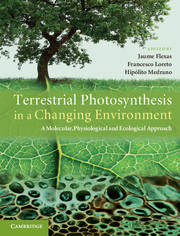 Terrestrial Photosynthesis in a Changing Environment
Terrestrial Photosynthesis in a Changing Environment Book contents
- Frontmatter
- Contents
- List of contributors
- Preface
- Acknowledgements
- List of abbreviations
- 1 Terrestrial photosynthesis in a changing environment
- Part I Photosynthesis
- 2 Biochemistry and photochemistry of terrestrial photosynthesis: a synopsis
- 3 Photosynthetic regulation
- 4 Interactions between photosynthesis and day respiration
- 5 The ecophysiology and global biology of C4 photosynthesis
- 6 Ecophysiology of CAM photosynthesis
- 7 Special photosynthetic adaptations
- 8 Models of photosynthesis
- Part II Measuring photosynthesis
- Part III Photosynthetic response to single environmental factors
- Part IV Photosynthesis in time
- Part V Photosynthesis in space
- Part VI Photosynthesis in a global context
- References
- Index
5 - The ecophysiology and global biology of C4 photosynthesis
Published online by Cambridge University Press: 05 March 2013
- Frontmatter
- Contents
- List of contributors
- Preface
- Acknowledgements
- List of abbreviations
- 1 Terrestrial photosynthesis in a changing environment
- Part I Photosynthesis
- 2 Biochemistry and photochemistry of terrestrial photosynthesis: a synopsis
- 3 Photosynthetic regulation
- 4 Interactions between photosynthesis and day respiration
- 5 The ecophysiology and global biology of C4 photosynthesis
- 6 Ecophysiology of CAM photosynthesis
- 7 Special photosynthetic adaptations
- 8 Models of photosynthesis
- Part II Measuring photosynthesis
- Part III Photosynthetic response to single environmental factors
- Part IV Photosynthesis in time
- Part V Photosynthesis in space
- Part VI Photosynthesis in a global context
- References
- Index
Summary
Introduction
The appearance of the C4 photosynthetic pathway in the Earth’s flora represents one of the most impressive and curious examples of evolutionary diversification and biogeographic expansion in the history of life (Ehleringer and Monson, 1983). This complex pathway, involving novel patterns of biochemical compartmentation and anatomical design, has evolved with independent but convergent patterns approximately fifty times during the relatively short geological span of 12–15 million years (Kellogg, 1999; Monson, 1999; Sage, 2004; Christin et al., 2007). The appearance of C4 photosynthesis has changed the nature of photosynthetic productivity and ecosystem structure on Earth, both regionally and globally. Grassland ecosystems emerged in southwestern Asia, Africa and North America during the mid- to late-Miocene (5–10 Ma) and continued through the Pliocene, (~3Ma), with many of these systems dominated by C4 species (Cerling, 1999; Beerling and Osborne, 2006). During the appearance of C4 grasslands, the trophic structures of grazed ecosystems were completely revised, resulting in the emergence of novel mammalian lineages (Cerling et al., 1993; Wang et al., 1994; MacFadden and Cerling, 1996; Ehleringer et al., 1997). Arguably, there is not a better example in the history of life to illustrate the tightly integrated nature of evolutionary novelty and ecological impact, as that shown in C4 photosynthesis. Clearly, C4 photosynthesis, though present in only 8,000 of the estimated 250,000 higher plant species, deserves a significant role in the discussion of plant biology.
- Type
- Chapter
- Information
- Terrestrial Photosynthesis in a Changing EnvironmentA Molecular, Physiological, and Ecological Approach, pp. 54 - 70Publisher: Cambridge University PressPrint publication year: 2012
